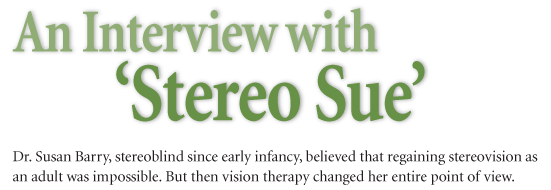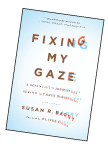
 Neurobiologist Susan Barry, Ph.D., was skeptical of vision therapy. She was taughtand firmly believedthat an adult with strabismus is long past the critical period and cannot recover stereovision. Then she was referred to Theresa J. Ruggiero, O.D., for vision therapy, and literally saw the world differently.
Neurobiologist Susan Barry, Ph.D., was skeptical of vision therapy. She was taughtand firmly believedthat an adult with strabismus is long past the critical period and cannot recover stereovision. Then she was referred to Theresa J. Ruggiero, O.D., for vision therapy, and literally saw the world differently.
Nicknamed Stereo Sue, Dr. Barrys experience was featured in a New Yorker article by eminent neurologist Oliver Sacks, M.D. Now, Dr. Barry has published a book, Fixing My Gaze, about her journey into the three-dimensional world. Review asked Dr. Barry to describe her experience and talk about how vision therapy completely changed her view of the world.
Review: How old were you when you realized that something was wrong with your vision?
Dr. Barry:
It wasnt until I was 20 years old, when I was taking a neurobiology class in college, that I learned that I did not have stereovision. I sat in the classroom one November day in 1973 and the professor described an experiment in which kittens had been made strabismic, and their vision didnt develop normally. The neurons in their braininstead of responding to both eyes like a normal neuron in the visual cortex of the brainresponded to only one or the other eye.
I was absolutely floored because I had been cross-eyed as an infant. But I had eye surgeries when I was 2, 3 and 7 years old, so my eyes looked straight most of the time. And I had 20/20 acuity in both eyes, so I assumed I had perfect vision.
The reason I got into neurobiology in the first place was that I was interested in animalsbirds, in particularand their behavior. But, I discovered as an undergraduate that I was really pretty bad at observing animals in their natural environment if they moved quicklyespecially birds. I couldnt see things moving fast. I just thought I was slow. But, because I always had 20/20 vision, I didnt necessarily connect this problem with my visionand neither did any of the school authorities or any of the doctors I saw.
Review: Talk about some of the doctors you saw.
Dr. Barry:
Eight years after sitting in this class and learning about stereovision, I went to my ophthalmologist and asked him, Do I have 3-D vision? He said, You probably do, because you have a Ph.D. I thought that was a little odd. I asked, Well, could you test me? He was kind of reluctant to do it, but he pulled out the Stereo Fly test, and I flunked it. I couldnt do it at all. Then he said, You dont need stereovision because you dont have stereovision. The logic of that statement eludes me to this day.
I had learned about stereopsis, of course, and the textbook description was that it gives you improved depth perception at the point of fixation, and not really anywhere else. So, I thought, Well, OK, Im missing this little added something to my vision. So, I cant go to a 3-D movie and enjoy it. No big deal.
I later found out that the textbook definition is by no means complete.
What I didnt realizeeven after becoming a neurobiology professor and lecturing on the development of the visual systemwas that the basic, nagging problems that I had with my vision were not just that my eyes didnt combine the input to produce a 3-D effect, but that they provided conflicting input. I shifted between which eye I looked through or fixated, and the two eyes were still misaligned. If I fixated on a target with my right eye, my left eye would turn in. And if I looked with my left eye, then the right one turned in. This conflicting input was really more of a problem than lack of stereovision. But the two are interrelated, because you cant have stereovision if the input thats coming in is conflicting.
The effect of this was that when I looked in the distance, the images would appear to jitter. Id be driving and trying to read the road sign, but I couldnt aim my eyes accurately on the letters. When my kids were in a play and I was sitting midway back in the auditorium, I couldnt see their faces clearly. There was this jitteriness.
This instability in my gaze got worse in my late 30s, early 40s. So I went to see another ophthalmologist who tested each eye separately and said my acuity was fine. He added, If you think theres a problem with your vision, its because you were traumatized by your early childhood surgeries and you dreamed up this problem, and you need to see a psychiatrist.
I left his officeafter grudgingly paying the billand I remember just fighting back the tears, I was so frustrated. But then I thought, Well, its really good news. He didnt say your complaints indicate that you have a brain tumor. He said my vision is fine. I figured if I were just less anxious, this problem would go away.
Review: But, of course, it didnt go away.
Dr. Barry:
No, it didnt. And without even thinking much about it, I began to change my behavior because of it. I drove as little as possible. I avoided eye contact with people when I talked to them. And, most of all, I just stopped looking in the distance, because thats where my vision was most jittery.
It went on like this for eight years until one day, when I was teaching an introductory biology class in a large classroom, my co-instructor said, Why dont you ever call on the kids in the back of the class?
I said, What kids? It wasnt that I couldnt see them. I just wasnt looking there.
I realized I had to do something about this, and at that point I was getting a little bit presbyopic, so I thought Id better go find an eye doctor and make sure my glasses prescription is still good. I went to see Dr. Steven Markow, whose optometry office is located across the street from
Review: When Dr. Ruggiero first talked about vision therapy for you, were you skeptical?
Dr. Barry:
Yes, I was very skeptical because I knewor I thought I knewfrom my scientific work that my brain had rewired itself for a sort of monocular way of seeing, that each neuron in my brain responded to one or the other eye, and I did not have the neuronal capacity to combine the input from the two eyes. So I didnt think it would produce any major changes in my vision, but maybe it would give me some strategies to cope.
My skepticism was only heightened when I first walked into the therapy room. It looked like a kindergarten classroom. There were red and green mylar sheets taped to the glass door, sheets with big numbers pasted onto the four corners of a wall, balls with letters on them hanging from the ceiling, strings with beads on them, and a balance board. Nothing like the typical eye doctors office. Not only that, but I had to share my vision therapy session with a five-year-old girl. This seemed pretty Mickey Mouse. I thought: Was I going to spend my hard-earned money to do this?
And yet, in the course of that first session when I was asked to gaze at these numbers posted on the four corners of a wall, I discovered that I really couldnt look down and keep my gaze straight. The view would oscillate when I would look at the numbers placed near the floor. Not only that, but the five-year-old girl could do the exercise much better! So I realized at that point, its time for me to stop having any preconceptions and just see what happens.
And what happened was that I had to go all the way back to the beginning. As you know, a normal baby learns how to see with two eyes in the first six months of lifebut I had not. So, at the age of 48, I had to relearn what it was like to see as a six-month-old.
How to Help Your VT Patients
Review: What would you recommend for the average optometrist who may not provide vision therapy?
Dr. Barry:
I dont want to tell optometrists what to do, but I would ask them to do what Steven Markow, O.D., did for me: Find a good developmental/behavioral optometrist in the area. (When people ask me for referrals, I tell them to look for a fellow of the
Review: Talk about the process of vision therapy. How much treatment did you receive? How much time did you spend each day?
Dr. Barry:
I saw the vision therapist at Dr. Ruggieros office for 45 minutes once a week during the course of about 12 months. She carried out the procedures that had been prescribed by Dr. Ruggiero. I did my vision therapy homework about 30 minutes every day, usually over breakfast. Its a lot like learning to play the piano.
In other words, if I never practiced, but only went for my lessons, I would have made piddling progress. But the more I practiced, the more I progressed. Its also true that doing just a little bit each day was very powerful. So I didnt have to change my life to do vision therapy, but I did have to put aside a small part of my life to do the therapy on a regular basis and I pretty much did it every day. And I still do therapy on my own now because I want to see how good I can get.
Review: When did you first see results?
Dr. Barry:
I started to see results fairly quickly. There were several major changes that happened in my vision. The first and most important was that my gaze stabilizedI could look in the distance without things being jittery. Along with that came a much clearer, crisper view of the world. Borders and edges around objects became much more defined. The input from my eyes was no longer conflicting, but providing correlated information to my brain. That effect happened during the course of the year that I was doing the vision therapy.
Then I started to see things in 3-D. I had been working on vision therapy for about six weeks, and the first thing I saw in 3-D was the steering wheel of my car floating in front of the dashboard. It happened right after a session with a tool called the Brock string. The stereovision came on gradually. It wasnt like I woke up one day and found myself seeing in 3-D.
Review: When you started, you merely hoped your vision would stabilize. But you were able to develop stereopsis. What other unanticipated results did you have?
Dr. Barry:
There were a lot. First, I learned that this phenomenon of stereopsis doesnt just apply for things right around the fixation plane. Rather, I got the powerful sense of being immersed in a three-dimensional world that I never experienced before. When I interviewed other people who gained stereovision in adulthood, they said exactly the same thing. Seeing the random dot stereogram is nice, but seeing how you are in space is far more spectacular. Before, if I looked at a snowfall, the snowflakes appeared a little distance away from me in one flat plane. When I gained stereovision, I felt myself within the snowfall: the snow was falling all around me in many levels of depth. Once your brain is receiving information from both eyes at the same time, and producing qualitative stereopsis, you get this powerful sense of immersionand that was a complete surprise.
The second surprise involved the phenomenon of motion parallax. When you move, the objects around you appear to movethe objects closer to you appear to move faster than objects further away. Motion parallax provides a type of depth perception you can see with one eye, so I always assumed I could use motion parallax to gauge depth just as well as anyone else. And that was completely wrong, because once I gained stereovision I could see the palpable volumes or pockets of space between objects. I did not just infer that the space existed. I would walk under a tree and I could see the pockets of space between all the branches. I had no idea that would happen.
Whats more, once I had that experience in real life, suddenly everything on TV is more depth filled. When I look at a painting in perspective, I see much more depth in it now because Ive had that experience with depth in real life.
But there was one other surprise that was completely unexpected. And that was the huge emotional high from gaining 3-D vision. Ive heard this over and over from other people as well. When I started to see in 3-D, it brought waves of absolute joy that are indescribable. I was just completely over the top emotionally. I tried to keep it to myself because if people started to ask me about it, I would go on and on about it. My husband and children were beginning to think I was nuts. There was this unbelievable sense of joy. I had no idea that it would produce this kind of effect on me, and still does.
 Review: Your book suggests that there may actually be a neurological basis for this joythat its the brains way of encouraging the central nervous system to strengthen neurosensory connections.
Review: Your book suggests that there may actually be a neurological basis for this joythat its the brains way of encouraging the central nervous system to strengthen neurosensory connections.
Dr. Barry:
Absolutely. My dopamine cells and reward circuits were firing like mad. As Ive had these wow experiences, Ive liberated these neuromodulators onto my visual cortex and actually facilitated further synaptic changes and made those changes more long term and robust. Its a positive feedback loopthe neuromodulators that were liberated in my brain were actually facilitating and strengthening the whole change in vision.
Thats why I think vision therapy, for many people, really affects the whole person. Its a very powerful experience, and thats something that I had no idea was going to happen. It truly changed the way I see the world, both literally and figuratively.
And you need support during this therapy. You need support from your optometrist and your vision therapist. The person providing the vision therapy really has to understand what the patient is going through. It can be joyful, but it can also be very confusing, frightening and exhausting. I had a lot of background in science to help me understand whats going on, but it was also very helpful to talk to other people who have gone through the experience. And, of course, the more support you have from your family members and friends, the more positive the experience will be. This is one of the main reasons I wrote the book.
Review: Its amazing to think you experienced such a profound change because, before you came in for vision therapy, you seemed to be successful in all areas of life. You have a Ph.D. from
Dr. Barry:
I always held back. And looking back on it, it had a lot to do with my vision. When I was a child, I had a hard time learning to read because when I looked at the letters, they didnt stay put on the page. By the time I got to third grade, I was put in a remedial class with all sorts of children with problems. The class was completely chaotic. The principal actually told my parents that they might as well face facts, they had a dumb kid. My mother was very concerned. She taught me to read, and she read with me, and put reading in a very positive light. Once I got to the point where I could read competently in fifth grade, I was finally moved out of that special problems class. I was absolutely paranoid about ending back up in it, so I became a fanatic student. I thought I was just slower than most people, so I just had to work harder to get to the same place.
I ended up looking like a successful person. But, I had designed my whole life around not driving a car. I never was that aggressive with my career. I never wanted to build a big lab and have lots of students and publish a lot of papers. I always held back.
And this sort of thing is still happening to kids over and over again. The eye chart in the school nurses office doesnt assess at all how a child uses his eyes when he reads. Maybe 5% of children have convergence insufficiency, which can impact your ability to readthats one in 20 kids, one child per classroom. Yet the tests that would reveal binocular vision problems are not performed in school, and the parents are not encouraged to have those tests done outside of school. So a lot of kids are suffering through school needlessly because their vision problems arent corrected. But the amazing thing is that many of these vision problems are correctable if you find the right optometrist and vision therapistas I finally did.
(For more information, see
http://fixingmygaze.com.)

